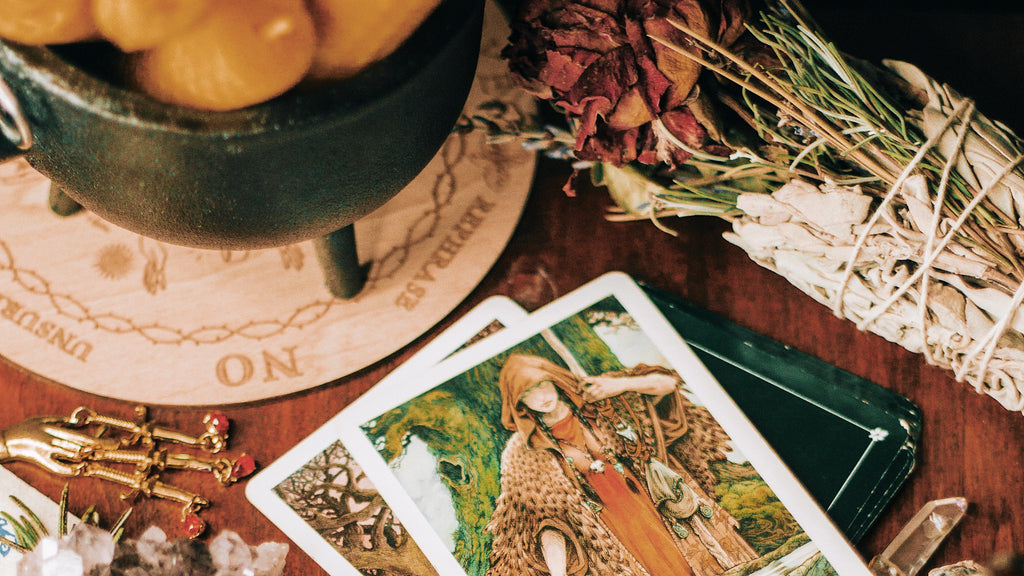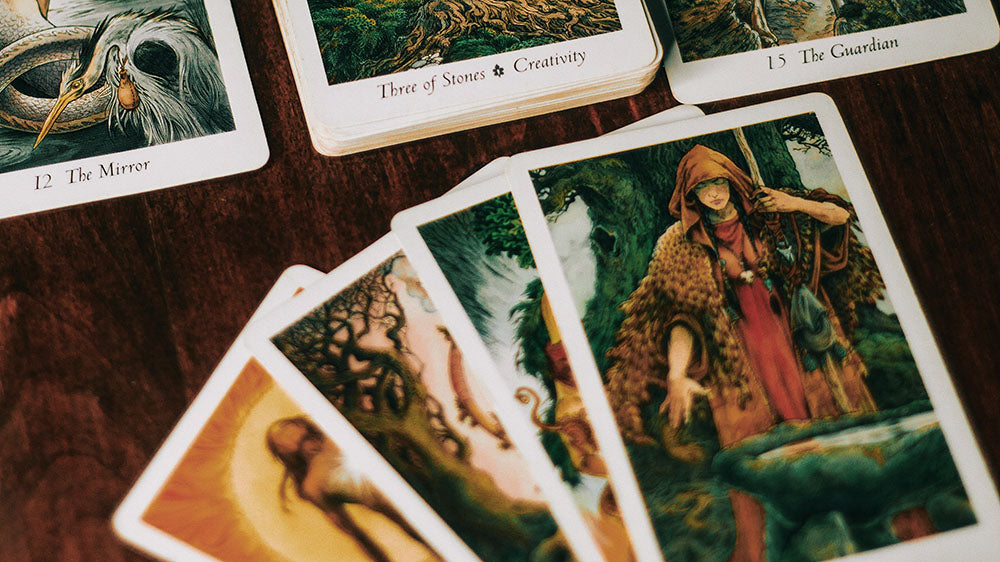Have you ever pulled a reversed tarot card (upside down) and thought, 'what the heck'? You're not alone, many tarot readers, especially beginners, view reversed cards with some confusion.
But do not fret; I’m here to tell you that these reversals are opportunities for deeper spiritual insights! So without further ado, here's everything you need to know about reading reversed Tarot cards.
Reversed Cards vs. Upright Cards:

Sometimes when shuffling, a card jumps out and lands in an upside-down manner. I’m sure you’ve experienced this in your practice. These are not mere accidents, but meaningful signs meant to guide your spiritual journey.
Tarot cards have two positions: the standard upright and the reversed. Upright cards convey their fundamental meanings, while reversed cards often represent challenges, delays, or blockages in relation to their core significance.
Take the Lovers card as an example:
- Upright Lovers Card: This card represents love and harmony, highlighting strong relationships and meaningful life choices aligned with personal beliefs.
- Reversed Lovers Card: Here, the focus shifts to relationship struggles and decision-making challenges. It can indicate conflicts, indecision, and a misalignment between actions and core values.
Now, you see how reversals can totally change the reading, offering a more nuanced perspective on the situation and possibly helping you make intuitive, higher-self, informed decisions.
The Misunderstood Nature of Reversals
Have you been in this position where you pull a reversed card from your tarot deck and feel tempted to flip it right-side-up? I’ve been there, too, as there can be associations with reversals that bear negative connotations.
It’s easy to understand why. Imagine pulling a reversed Sun card - typically a symbol of joy and positivity. In its reversed state, it seems like the cards are clouding your sun rays. However, there’s a flip side worth exploring that can actually be beneficial for your spiritual growth.
Let’s explore the top 3 common misconceptions that may be preventing you from getting your most honest, soul-growing reading.
- Not Solely Negative: A common myth is that reversed cards always symbolize negativity. In truth, they can indicate challenges, but also represent change, new directions, and unique perspectives. Their significance varies with the context, not just confined to adverse meanings.
- Flexible Interpretations: Contrary to the belief in fixed meanings, the interpretation of reversed cards is subjective and heavily reliant on the specific context of each reading. They don't always mirror the exact opposite of their upright positions but can offer a spectrum of interpretations, showing nuances and complexities related to the card's traditional essence.
- Beyond Predicting Doom: Reversed cards don't exclusively predict negative outcomes. They often serve as indicators for areas needing focus, opportunities for personal growth, and invitations for introspection and evolution.
In essence, the misunderstood nature of reversals in Tarot stems from the idea that they are rigid or uniformly negative. In reality, Tarot readings are a blend of symbolism, intuition, and personal connection.
Interpreting reversed cards effectively requires flexibility, context awareness, and a willingness to embrace the depth and complexity they add to a reading.
You should approach reversed cards with an open mind, taking into account the specific question and the energy of the reading.
Interpreting Reversed Tarot Cards

Life is rarely straightforward, and neither are tarot readings. Reversed Tarot cards can have multiple interpretations, and their meanings may vary depending on the context of the reading and the reader's intuition.
Common interpretations of reversed cards include:
- Blocked Energy: Reversed cards can indicate a blockage or resistance related to the card's symbolism.
- Opposite or Inverse Meaning: Sometimes, reversed cards represent the opposite of their upright meanings.
- Inner Conflict: They may suggest internal conflicts, doubts, or hesitation.
- Delay or Slow Progress: Reversed cards can signify delays or obstacles in the situation represented by the card.
Note: Context matters, the meaning of your reversed Tarot card is heavily influenced by the surrounding cards in your spread and the question or issue being addressed. You should consider the overall energy of your reading and how the reversed card fits into the narrative.
Clarifying the Reversed Messages

Using a clarifier card in conjunction with reversed Tarot cards is a technique that you can employ to gain further insight and clarification when a reversed card appears in a reading. Here's how it works:
1. Draw a Reversed Tarot Card:
When a reversed (upside-down) Tarot card appears in your spread, it suggests that there may be challenges, blockages, or a need for a different perspective related to the card's traditional meaning. The reversed card alone provides some information, but it may not offer a complete picture.
2. Draw a Clarifier Card:
To gain more clarity and depth in the interpretation of the reversed card, you can draw an additional card from the deck. This card is known as the "clarifier card."
3. Interpret the Clarifier Card:
The clarifier card is drawn upright and is interpreted in the context of the reversed card it is clarifying. Its purpose is to provide additional information, insights, or nuances related to the reversed card.
- Positive Reinforcement: Sometimes, the clarifier card reaffirms the reversed card's meaning or provides a positive perspective on the situation. It can confirm the challenges or issues indicated by the reversed card.
- Different Perspective: In other cases, the clarifier card may contrast with the reversed card, offering a different angle or suggesting that the challenges are not as severe as they initially seem. It can soften the negative aspects or offer a solution.
- Additional Details: The clarifier card may bring in new elements, themes, or emotions that weren't evident in the reversed card alone. It helps you dig deeper into the situation.
4. Integrate the Interpretation:
After interpreting the clarifier card, you will integrate this information into your overall reading. Consider how the clarified meaning of the reversed card fits into your question or issue, taking into account both cards' symbolism and your intuition.
Conclusion: Embrace the Reversal for Spiritual Enlightenment

In closing, there's no need to dread reversed Tarot cards. Instead, view them as catalysts for deeper self-exploration and growth. The next time a reversed card appears in your spread, pause and consider the unique insights it offers.
FAQs about Tarot Reversals
- What does a reversal mean in tarot readings? Reversals in Tarot are not just simple opposites of the upright meanings. They can indicate challenges, inner reflections, delays, or alternative interpretations based on the context of the reading.
- How can I use a clarifier card with a reversed card? When a reversed card appears, draw another card from the deck as your clarifier. This card will help you gain deeper insight into the reversed card's meaning, revealing additional layers or suggesting alternative perspectives.
- Can all tarot cards be read in reverse? Yes, every card in the Tarot deck can be read in reverse. However, the significance of the reversal can vary greatly depending on the card, the context of the reading, and the reader’s intuition.
- Are reversed cards always negative? Not necessarily. While they often highlight challenges or obstacles, reversed cards can also signify internal growth, the need for introspection, or the emergence of new viewpoints.
- How do I interpret a reversed card in a positive spread? Even in positive spreads, a reversed card can indicate areas requiring attention or improvement. It’s important to integrate its meaning into the broader context of the spread, looking for ways it might suggest growth or caution.
- Should I always use clarifier cards for reversals? Using clarifier cards is not mandatory but can be helpful, especially for beginners or in complex readings. It provides additional information and can make the interpretation of a reversed card clearer.
- Do reversed cards have a stronger impact than upright cards? The impact of a reversed card is not necessarily stronger, but it can bring a different dimension or a nuanced understanding to the reading, often calling for deeper introspection.
- How can I practice reading reversals more effectively? Regular practice and keeping a Tarot journal can be helpful. Note down your interpretations and feelings about reversed cards in different readings and contexts to enhance your understanding over time.
- Is there a specific spread that works best with reversals? Reversals can be incorporated into any Tarot spread. However, spreads that focus on personal growth or overcoming challenges may particularly benefit from the insights provided by reversed cards.
- How do I explain reversed cards to someone receiving a reading? When explaining reversals to someone, focus on the card's message in the context of the reading. Emphasize that reversals are not inherently negative but offer a chance for deeper understanding and personal growth.
☘☘☘
Craving more spiritual discoveries? Get your dose of transformative insights and practical witch tips delivered straight to your inbox—sign up now!
Related Posts:
How to: 13-Card New Year Ahead Tarot Spread

